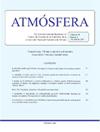气候振荡驱动下墨西哥NDVI的结构变化点
IF 1
4区 地球科学
Q4 METEOROLOGY & ATMOSPHERIC SCIENCES
引用次数: 0
摘要
基于气温、降水和归一化植被指数(NDVI)的气候学,通过一种称为DBSCAN的非参数聚类算法给出了墨西哥雨季的分区。利用1984 - 2013年30年的数据,利用Mann-Kendall和Pettitt对NDVI、平均日降水量、第99百分位降水量和平均日气温进行非参数检验,检测结构变化点。使用机器学习随机森林算法估计了所检查参数的相对预测重要性,该算法允许在NDVI变化与某些地区的气温、平均降水和极端降水变化之间建立联系。探讨了大尺度气候现象的调制,如大西洋多年代际振荡(AMO)和太平洋年代际振荡(PDO),以及厄尔Niño/南方涛动(ENSO)的年际调制。在1997年,该序列的结构变化点主要是由AMO和ENSO和PDO的相移调制的。本文章由计算机程序翻译,如有差异,请以英文原文为准。
Structural change points of NDVI in Mexico driven by climate oscillatio
Based on the climatology of air temperature, precipitation, and the normalized vegetation index (NDVI), a regionalization of Mexico for the rainy season is presented through a non-parametric clustering algorithm known as DBSCAN. Thirty years of data, spanning from 1984 to 2013, are used to detect structural change points with the Mann-Kendall and Pettitt non-parametric tests applied on the NDVI, mean daily precipitation, 99th percentile precipitation, and mean daily air temperature. The relative predictive importance of the parameters examined was estimated using a Machine-Learning Random Forest algorithm that allows establishing a connection between changes in the NDVI and changes in air temperature, average precipitation, and extreme precipitation for some regions. Modulation by large-scale climate phenomena, such as the Atlantic Multidecadal Oscillation (AMO) and the Pacific Decadal Oscillation (PDO), as well as interannual modulation by El Niño/Southern Oscillation (ENSO) are explored. Structural change points in the series appear to be modulated mainly by the phase shift of the AMO and those of the ENSO and PDO in 1997.
求助全文
通过发布文献求助,成功后即可免费获取论文全文。
去求助
来源期刊

Atmosfera
地学-气象与大气科学
CiteScore
2.20
自引率
0.00%
发文量
46
审稿时长
6 months
期刊介绍:
ATMÓSFERA seeks contributions on theoretical, basic, empirical and applied research in all the areas of atmospheric sciences, with emphasis on meteorology, climatology, aeronomy, physics, chemistry, and aerobiology. Interdisciplinary contributions are also accepted; especially those related with oceanography, hydrology, climate variability and change, ecology, forestry, glaciology, agriculture, environmental pollution, and other topics related to economy and society as they are affected by atmospheric hazards.
 求助内容:
求助内容: 应助结果提醒方式:
应助结果提醒方式:


